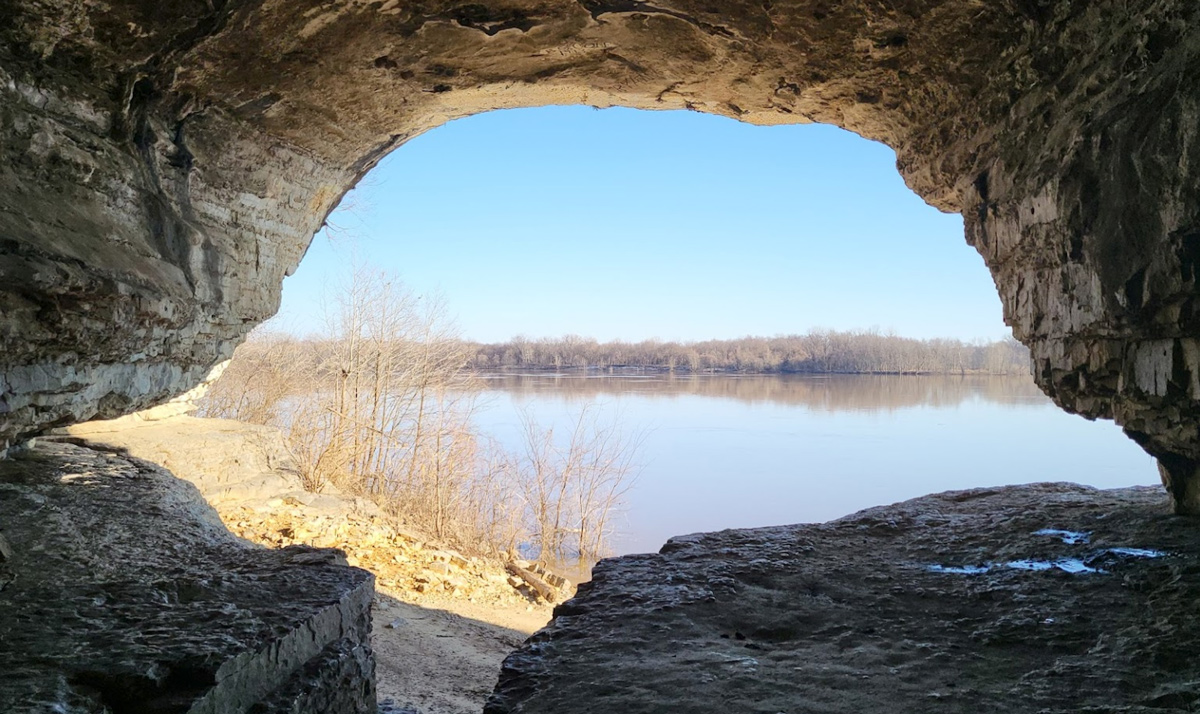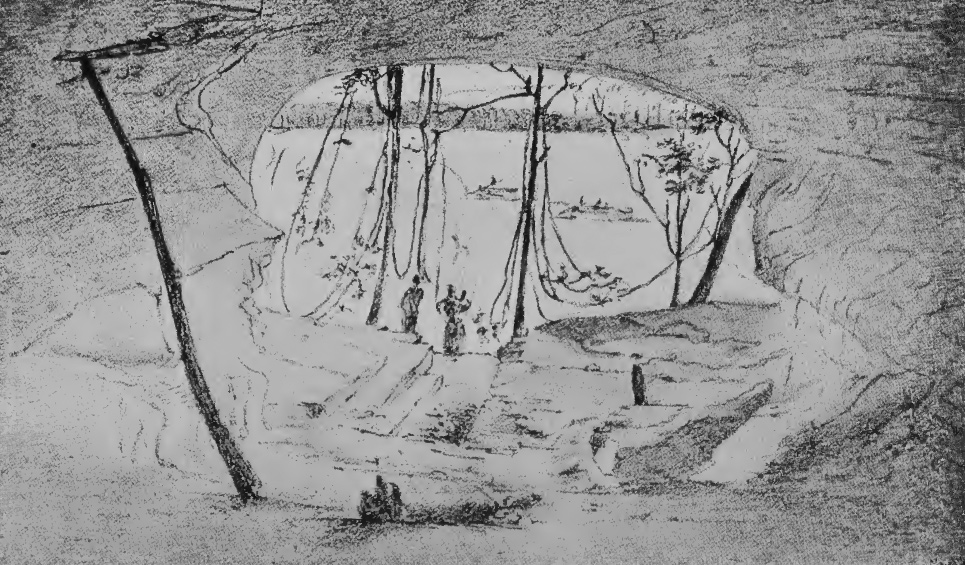On or near this date, the expedition passes Cave-in-Rock—a hangout for the notorious Mason Gang. After several members escape from imprisonment, Mississippi Territorial Governor William Claiborne offers a $1,000 reward for their return—dead or alive.[1]No daily record of expedition’s travel between Louisville and Fort Massac is known to exist. Locating them near Cave-in-Rock on this date is an estimate based on information from travelers of the … Continue reading
Cave in View
The cave, however, is easily discovered, as no one can well pass it by day light without seeing it if they look that way, the trees before it being too few and small to interupt the view. The stupendious wall of rocks which appear to be chiefly limestone ends a little below the cave.
—Thomas Rodney (31 October 1803)[2]Dwight L. Smith and Ray Swick, ed., A Journey Through the West: Thomas Rodney’s 1803 Journal from Delaware to the Mississippi Territory (Athens: Ohio University Press, 1997), 154.
Fine Grotto
[O]ne of the finest grottos or caverns I have ever seen, opened suddenly to view, resembling the choir of a large church as we looked directly into it. We landed immediately under it and entered it. It is natural, but is evidently improved by art in the cutting of an entrance three feet wide through the rock in the very centre, leaving a projection on each hand excavated above to the whole breadth of the cavern, the projections resembling galleries. The height of the mouth is about twenty-two, and that of the rock about thirty. It is crowned by large cedars and black and white oaks, some of which impend over, and several beautiful shrubs and flowers, particularly very rich columbines, are thickly scattered all around the entrance. The length (or depth) of the cavern is fifty-five paces, and its breadth eleven or twelve.
—Fortescue Cuming (1807)[3]Fortescue Cuming, Sketches of a Tour to the Western Country: Through the States of Ohio and Kentucky, a voyage down the Ohio and Mississippi rivers, and a trip through the Mississippi territory, and … Continue reading
Graffiti
The front, sides, and top of the cavern as high as people can reach are full of names. I believe there is thousands of them. All who visit it no doubt leave their names there and so did we.
—Thomas Rodney (31 October 1803)[4]Rodney, 153.
No trace of a Lewis and Clark Expedition-related signature at Rock-in-Cave has been reported. They did leave their marks in other places on the trail. See Trail Graffiti.
Outlaw Hideaway
If Lewis and Clark visited Cave-in-Rock, they may have done so with an air of caution. For many years prior, Cave-in-Rock served as a hangout for the Mason Gang. Samuel Mason’s river pirates operated variously on the Ohio, Mississippi, and Missouri. They were also highwaymen on the Natchez Trace. In early 1803, several of the gang escaped custody while being extradited from Spanish territory.
Clark would likely have been well-informed about the escape. The Cincinnati Western Spy was first to print the story quoting a letter from Reverend John Smith dated 28 March 1803:
The day before yesterday as they were passing this place the mast of their vessel broke, a part of the men were sent on shore to make a new one, and the rest were left to guard the prisoners. In a short time they threw off their irons, seized the guns belonging to the boat and fired upon the guard. Captain McCoy hearing the alarm ran out of the cabin, old Mason instantly shot him through the breast and shoulder; he with the determined bravery of a soldier, though scarcely able to stand, shot him in the head.[5]Otto A. Rothert, The Outlaws of Cave-in-Rock (Cleveland: The Arthur H. Clark Company, 1924), 247. Captain Robert McCoy was neither crippled or killed in the escape and died in 1840.
After the escape, Mississippi Territorial Governor William Claiborne, offered a $1,000 reward for Mason, dead or alive and the manhunt was in full pursuit as Lewis and Clark passed Cave-in-Rock in early November 1803. During the winter of 1803–04, two men delivered Mason’s head, but they themselves were discovered to be members of the gang.
The two were hanged near Greenville in Jefferson County, the day Clark received invitations to various balls in St. Louis, 8 February 1804.[6]Rothert, 261. See also Samuel Mason, Wikipedia,” en.wikipedia.org/wiki/Samuel_MasonL accessed on 19 January 2019. The Natchez Trace experienced no shortage of highwaymen which made all the more risky, Lewis’s last journey as described in The Last Journey of Meriwether Lewis by Clay S. Jenkinson.
Experience the Lewis and Clark Trail
The Lewis and Clark Trail Experience—our sister site at lewisandclark.travel—connects the world to people and places on the Lewis and Clark Trail.
Plan a trip related to November 7, 1803:

Notes
| ↑1 | No daily record of expedition’s travel between Louisville and Fort Massac is known to exist. Locating them near Cave-in-Rock on this date is an estimate based on information from travelers of the period and Cramer’s 1802 river guide, The Navigator. |
|---|---|
| ↑2 | Dwight L. Smith and Ray Swick, ed., A Journey Through the West: Thomas Rodney’s 1803 Journal from Delaware to the Mississippi Territory (Athens: Ohio University Press, 1997), 154. |
| ↑3 | Fortescue Cuming, Sketches of a Tour to the Western Country: Through the States of Ohio and Kentucky, a voyage down the Ohio and Mississippi rivers, and a trip through the Mississippi territory, and part of West Florida, commenced at Philadelphia in the winter of 1807 . . . (Pittsburgh: Cramer, Spear, & Eichbaum, 1810). |
| ↑4 | Rodney, 153. |
| ↑5 | Otto A. Rothert, The Outlaws of Cave-in-Rock (Cleveland: The Arthur H. Clark Company, 1924), 247. Captain Robert McCoy was neither crippled or killed in the escape and died in 1840. |
| ↑6 | Rothert, 261. See also Samuel Mason, Wikipedia,” en.wikipedia.org/wiki/Samuel_MasonL accessed on 19 January 2019. |



